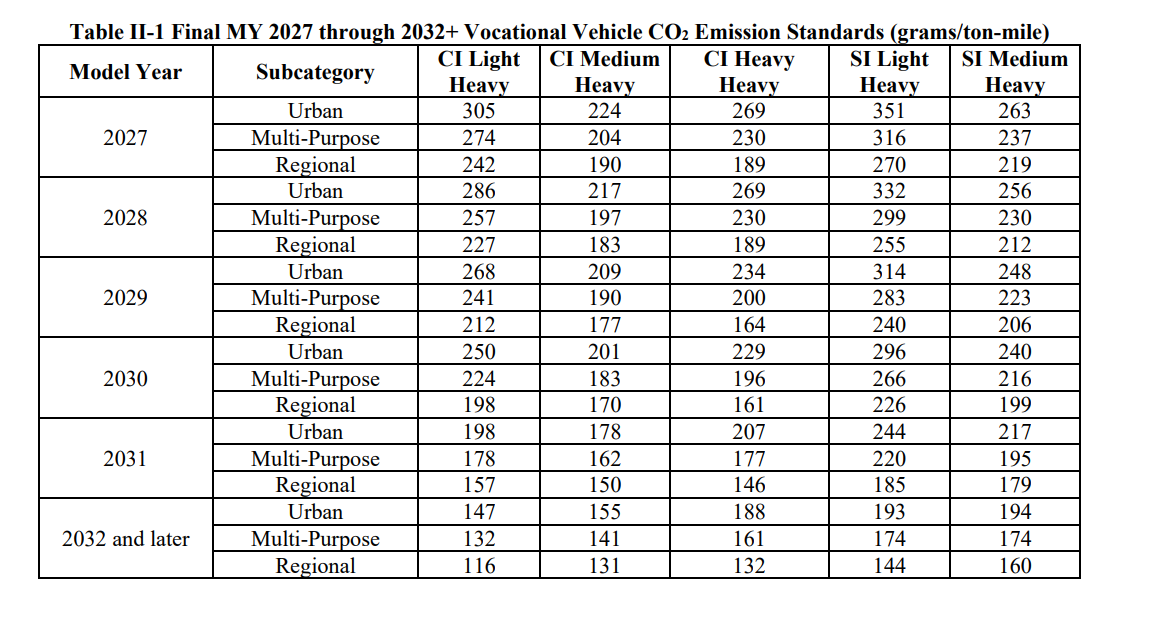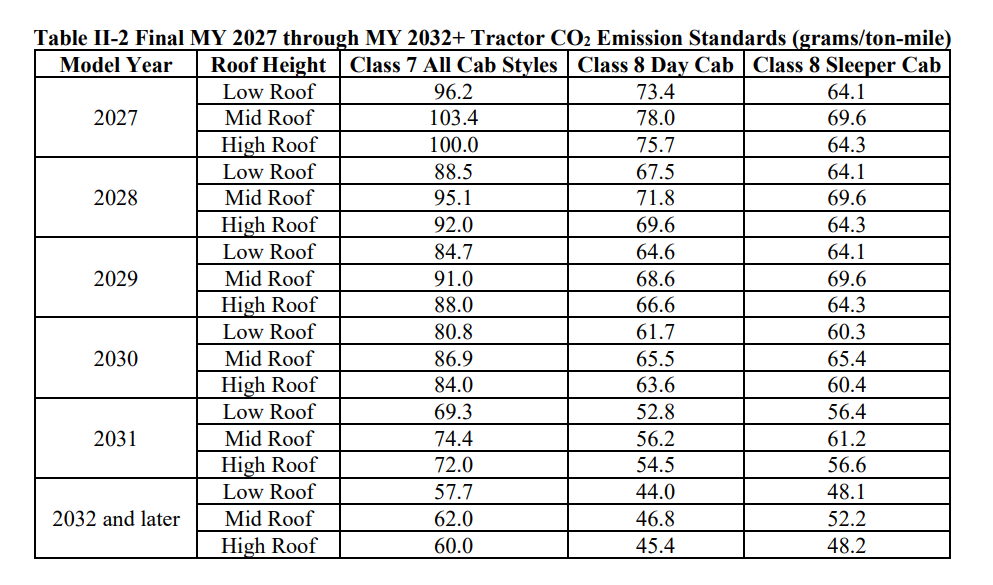See pre-publication version of the Phase 3 final rule linked here: “Greenhouse Gas Emissions Standards for Heavy-Duty Vehicles – Phase 3.”)
Overview of EPA MY2027-2032 GHG Standards
Context
The Phase 3 rule is the third rulemaking under EPA’s Clean Trucks Plan. EPA finalized its criteria pollutant rule for MY2027 and later heavy-duty engines and vehicles on December 20, 2022; its “Multi-Pollutant Emissions Standards for Model Years 2027 and Later Light-Duty and Medium-Duty Vehicles” on March 20, 2024; and its Phase 3 rule on March 29, 2024. Unlike the heavy-duty GHG Phase 1 and Phase 2 rules, which were jointly developed by EPA and the National Highway Traffic Safety Administration, EPA finalized the Phase 3 rule on its own. According to EPA, EPA coordinated with NHTSA and consulted with the California Air Resources Board during the development of the Phase 3 rule.
Final MY2027-2032 GHG Standards
The final rule revises the Phase 2 MY2027 standards for most categories of vehicles and establishes new, more stringent GHG emission standards for MYs 2028-2032 using the same regulatory subcategories of vehicles that were adopted in the heavy-duty GHG Phase 2 rule, including separate standards for optional custom chassis vehicles and heavy-haul tractors. Compared to the proposed standards, the final standards are less stringent for all vehicle categories in MYs 2027-2030 but still more stringent than the Phase 2 requirements. The final standards increase in stringency at a slower pace from MY2027 to MY2030 compared to the proposal, with the day cab tractor standards starting in MY2028 and the heavy heavy-duty vocational vehicle standards starting in MY2029, rather than MY2027 as proposed. The final standards for sleeper cab tractors, which start in MY2030, are less stringent than proposed in MY2030 and MY2031. Heavy heavy-duty vocational vehicle final standards are less stringent than proposed for all model years, including MY2031 and MY2032. For MY2032, EPA finalized more stringent standards than proposed for light and medium heavy-duty vocational vehicles and day cab tractors. EPA also revised some of the optional custom chassis standards compared to those EPA had proposed. The MY2032 standards will remain in place for MY2033 and beyond, unless EPA issues new standards through a future rulemaking.

See Table II-1, Final Rule.

See Table II-2, Final Rule.
For the final rule, EPA also evaluated technology packages from additional example potential compliance pathways. The additional example potential compliance pathways include only vehicles with ICE technologies.
EPA also updated its projected ZEV adoption rates for the MY 2027-2032 technology packages analyzed for the final rule. For example, in MY2032, EPA’s projected ZEV adoption rate is 60% for light heavy-duty vocational vehicles, 40% for medium heavy-duty vocational vehicles, and 30% for heavy heavy-duty vocational vehicles. For day cab tractors, EPA’s projected ZEV adoption rate is 0% in MY2027 increasing to 40% in MY2032, while for sleeper cab tractors, EPA projects 0% ZEV adoption in MY2027-2029, 6% in MY2030, 12% in MY2031, and 25% in MY2032, as shown in the table below.

See Table 2-105, Final Rule Regulatory Impact Analysis.
Final PHEV/BEV Battery Durability and Warranty Requirements
Battery Durability
EPA’s final rule establishes new battery durability monitoring requirements for heavy-duty PHEVs and BEVs beginning with MY2027. EPA determined that UN Global Technical Regulation (GTR) No. 22 is appropriate for ensuring battery durability and therefore made the requirements and general framework of its Phase 3 battery durability program largely identical to those of GTR No. 22.
Heavy-duty BEVs and PHEVs will be required to include an onboard battery state-of-health monitor that reports the vehicle’s state of certified energy and can be read by the vehicle user. EPA expects that manufacturers will implement onboard algorithms to estimate the state of usable battery energy (UBE) expressed as a percentage of the original UBE when the vehicle was new. For heavy-duty PHEVs, manufacturers will use the existing powertrain test procedures to determine UBE, while manufacturers will develop and obtain EPA approval of their own test procedures for heavy-duty BEVs, due to the range of BEV architectures and limited availability of heavy-duty BEV powertrain testing facilities. Manufacturers also have the option to develop and obtain EPA approval of their own test procedures for determining UBE for PHEVs. EPA finalized specific criteria for UBE test procedures intended to ensure that they produce accurate results that are representative of actual in-use operation.
EPA did not establish durability monitoring requirements for fuel cell electric vehicles (FCEVs) at this time because the technology is developing and EPA is still evaluating the appropriate metric for quantifying FCEV performance.
Battery Warranty
EPA also finalized new warranty requirements for MY2027 and later ZEV (BEV and FCEV) batteries and associated electric powertrain components (e.g., fuel-cell stack, electric motors, and inverters) and clarified how existing warranty requirements apply to PHEVs. For heavy-duty BEVs and FCEVs, manufacturers are required to designate the batteries and associated electric powertrain components as components covered under the emission-related warranty in the vehicle’s certification application and subject to the existing GHG emission warranty periods of 5 years or 50,000 miles for light heavy-duty vehicles and 5 years or 100,000 miles for medium and heavy heavy-duty vehicles. EPA now requires manufacturers, in their certification application, to “describe in detail all components needed to charge the system, store energy, and transmit power to move the vehicle” for any vehicle using a rechargeable energy storage system, which is intended to help define which components are covered under the emission-related warranty. EPA did not establish new battery warranty requirements for PHEVs because “hybrid system components” included in a manufacturer’s certified configuration are already addressed under the existing regulations.
Changes to the ABT Program
EPA also added flexibilities to the Averaging, Banking, and Trading (ABT) program as part of the Phase 3 final rule. The final rule revises the definition of “U.S.-directed production volume” to clarify that nationwide production volumes should be considered for the ABT program, including vehicles certified to different state emission standards, in contrast to EPA’s approach under earlier heavy-duty GHG regulations. The definition will apply starting with MY2024 to provide consistent treatment of production volumes certified under the Advanced Clean Trucks Regulation in California.
EPA did not finalize its proposal for an earlier phase-out of multipliers for PHEVs and BEVs. As such, manufacturers may continue to generate credits that include credit multipliers for PHEV, BEV, and FCEV technologies through MY2027. However, EPA is placing restrictions on how credits from multipliers can be used to meet the Phase 3 standards and is additionally limiting their use to the initial model years of the Phase 3 program, MYs 2027-2029.
Additionally, the final rule provides transitional flexibility in MYs 2027-2032 for manufacturers to use credits generated from heavy-duty vehicles across averaging sets. Specifically, during MYs 2027-2032, manufacturers can transfer credits generated from heavy-duty vehicles in MYs 2027-2032 between all heavy-duty vehicle averaging sets. Thus, manufacturers can transfer credits from light to medium or heavy heavy-duty vehicles, from medium to light or heavy heavy-duty vehicles, and from heavy to light or medium heavy-duty vehicles. This interim provision includes credits generated by all heavy-duty vehicles, including those using ICE-based vehicle technologies and is not limited to Phase 2 advanced technologies. In addition, EPA has provided an interim allowance for manufacturers to transfer credits generated by MY2027-2032 medium-duty vehicles (Class 2b and 3 pickup trucks and vans) to light and medium heavy-duty vehicle averaging sets, which is available until MY2032.
The final rule will take effect 60 days after publication in the Federal Register.